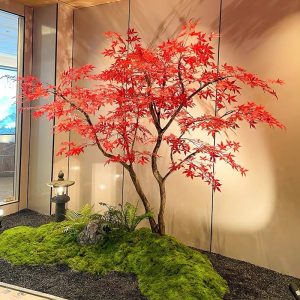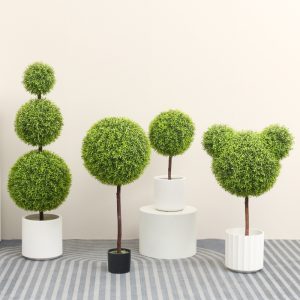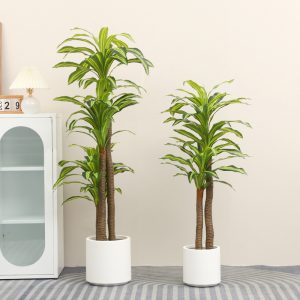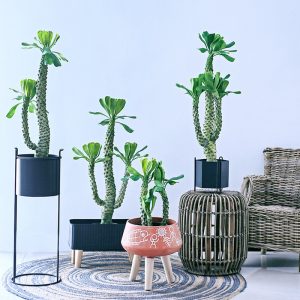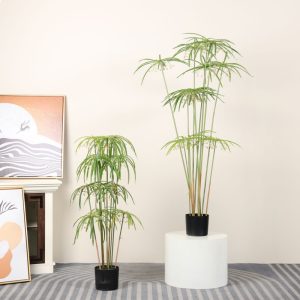Having worked in the artificial plant industry for many years, I’ve seen many artificial plants discarded over minor damages—broken branches, faded leaves, or fallen petals. In fact, 80% of these seemingly serious “injuries” can be repaired. Based on our hands-on experience, scientifically repaired artificial plants can last over 60% longer, and you can save 30%-50% on replacement costs. Today, I’ll share repair tips and renovation methods for different materials, bringing your old artificial plants back to life.
1. Before You Start: Is This Plant Worth Repairing?
Before diving into repairs, follow these “three-step assessments” to avoid wasting effort:
- Check the skeleton (structural integrity): If the main stem or large branches are broken in more than three places, especially near the roots, it’s labor-intensive to repair, and the result may not be satisfactory.
- Check the “skin” (material aging): Lightly scratch the surface of the leaves. If white powder comes off (PVC material) or fibers are exposed (fabric), it indicates severe material aging, and repairs may not last long.
- Check the “decorations” (core parts condition): If more than half of the flowers or fruit are missing, replacing these parts may cost more than buying a new plant. It might be better to replace the components entirely.
Based on our repair experience, 90% of minor damages (such as a single broken branch or localized fading) are worth repairing. However, if the overall aging is severe, the repair may not be cost-effective.
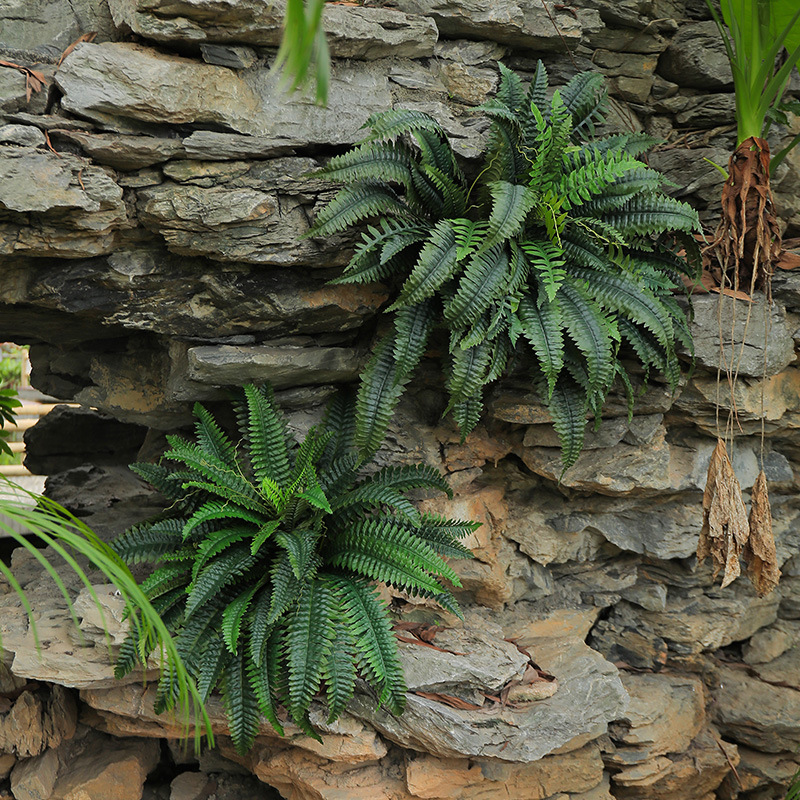
2. Repairing by Material: Targeted Solutions for Common Problems
PVC Material (Leaves/Branches)
Common damages: Broken branches, curled leaves, and chipped edges.
- Broken Branch Repair:
- Use fine sandpaper to smooth the jagged edges of the break.
- Apply a PVC-specific adhesive (preferably one containing methyl methacrylate, which is 40% stronger than regular glue).
- Align the break, secure with tape, and leave it undisturbed for 24 hours.
- Once dry, use acrylic paint to touch up the seam and finish with a clear matte spray to avoid glare from the repair.
- Faded/Curling Leaf Repair:
- Soak curling leaves in 60°C warm water for 10 minutes.
- After soaking, press the leaves flat with a heavy object, placing a damp towel underneath to avoid staining.
- Lightly brush fabric dye on faded areas, allowing 20 minutes to dry before repeating the process until the color is uniform.
Fabric Material (Petals/Fuzzy Leaves)
Common damages: Worn edges, tears, and shedding fibers.
- Tear Repair:
- Use tweezers to align the tear and place non-woven fabric on the back.
- Sew the tear with a fine needle and matching thread using a whipstitch.
- After stitching, use a steam iron on low heat to smooth the fabric.
- Fiber Shedding Repair:
- Apply a thin layer of diluted white glue (mix 1:1 with water) to the shedding area.
- Sprinkle matching color fibers (can use yarn from an old sweater).
- Let it dry for 24 hours, then use a soft brush to comb the fibers into place.
Silicone Material (Artificial Flowers/Succulents)
Common damages: Surface cracks, deformation, and staining.
- Crack Repair:
- Clean the area around the crack with alcohol to remove oil.
- Fill with silicone repair paste (choose a silicone with the appropriate hardness—A20 for soft, A60 for hard).
- Use powder to smooth the repaired area, and once dry, lightly sand it to level the surface.
- Stain Removal:
- For light stains (e.g., coffee), use a cotton swab dipped in 3% hydrogen peroxide and gently apply to the stain. After 5 minutes, wipe it off with clean water.
- For stubborn dark stains, lightly sand the surface, then apply matching color silicone paint.
PE Material (Large Leaves/Trunks)
Common damages: Fragility and surface scratches.
- Break Repair:
- Drill small holes at the break and insert a wire of appropriate thickness.
- Use hot glue to fill the seam, smooth excess glue with a utility knife once it dries, and finish by sanding the repaired area.
- Scratch Repair:
- Use a low-temperature heat gun (50°C) to blow air on the scratch for 30 seconds.
- Immediately press with a cotton cloth to allow the scratch to bounce back. If the scratch is deep, use filling paste.
3. Renovation and Upgrade: Not Just Repair, But a “New Look”
Once repairs are done, you can take your plant’s aesthetics to the next level, even making it look better than when it was first bought:
- Style Transformation:
- Modern Minimalist: Trim unnecessary branches, leave the main stem, and uniformly trim the leaves. Pair with a cement pot and spray a matte protective coat.
- Vintage Forest Style: Wrap the main branches with hemp rope, use coffee-colored dye on the edges of the leaves to create a weathered look, and pair with a retro ceramic pot.
- Fresh Nordic Style: Change the leaves to white or light pink, add dried flowers as accents, and cover the pot with a knitted sleeve.
- Component Upgrades:
- Low-Cost New Parts: Buy generic artificial flowers or leaves to replace over 50% of the damaged components, saving 70% on costs.
- Custom Personalization: Add fine copper wire LED lights to the main branches or fluorescent stickers on the back of the leaves. This is ideal for bars or children’s rooms.
- Change of Location:
- Wall Hanging: Install strong hooks, trim any long branches, ensuring they don’t exceed 5 cm in thickness.
- Hanging: Add adjustable nylon ropes and tie weighted sandbags to maintain balance.
4. Keep These “First Aid Tools” at Home for DIY Repairs
- Adhesive Power: PVC-specific glue, silicone repair paste.
- Repair Materials: Acrylic paint, non-woven fabric, fine steel wire.
- Precision Tools: Precision tweezers, fine needles, sandpaper.
- Shaping Tools: Low-temperature heat gun, steam iron.
With these tools, you can easily repair most common damages to your artificial plants at home.
5. Avoid These Repair Pitfalls!
- Don’t Use 502 Glue!: 502 glue can damage fabric and silicone, making them hard and brittle.
- Don’t Wash Right After Repair!: Water will cause the adhesive to fail if applied before it dries fully. Avoid water exposure for 72 hours after repair.
- Only Fix the Surface?: If the interior of branches is broken, just fixing the outer layer won’t help.
- Replacing Leaves Without Matching?: New leaves that don’t match the size or angle of the old ones will disrupt the overall look.
By following the correct repair methods, the lifespan of artificial plants can typically be extended by 2-3 years. With regular renovations, especially in high-traffic areas like malls or restaurants, plants can last up to 5 years or more. If you have special-shaped artificial plants in need of repair advice, feel free to share the details, and I’ll provide tailored solutions for you.








